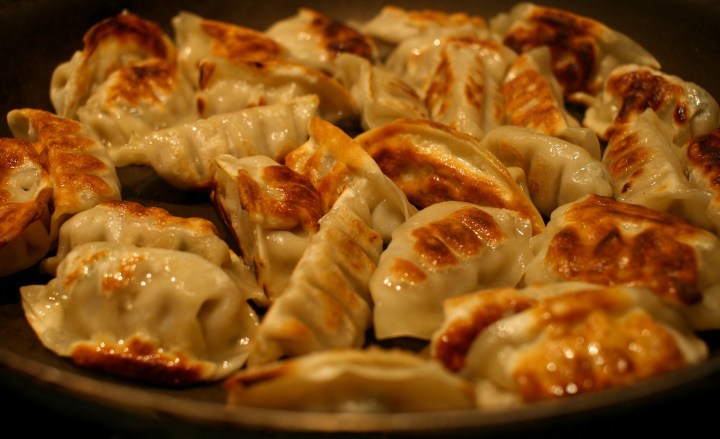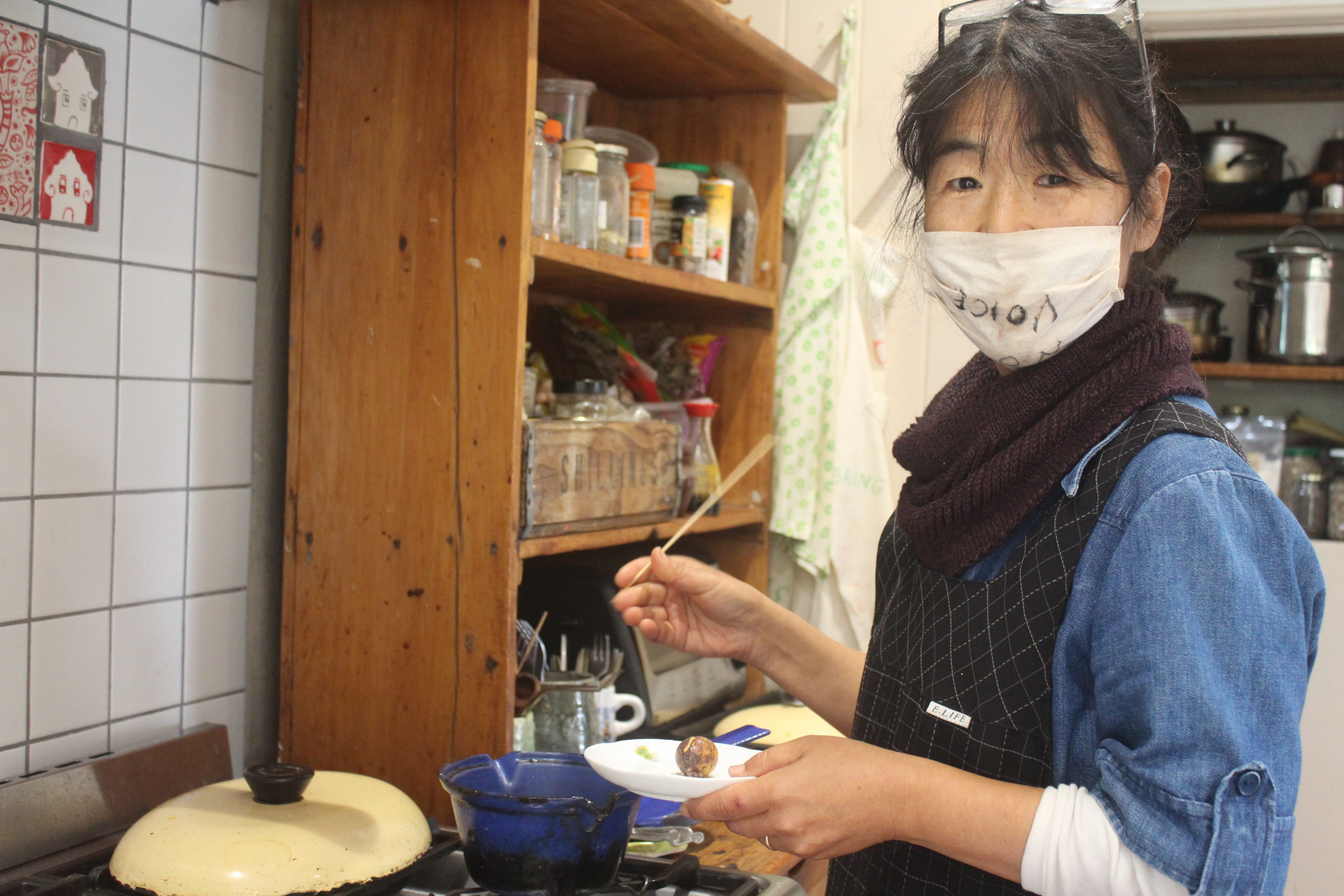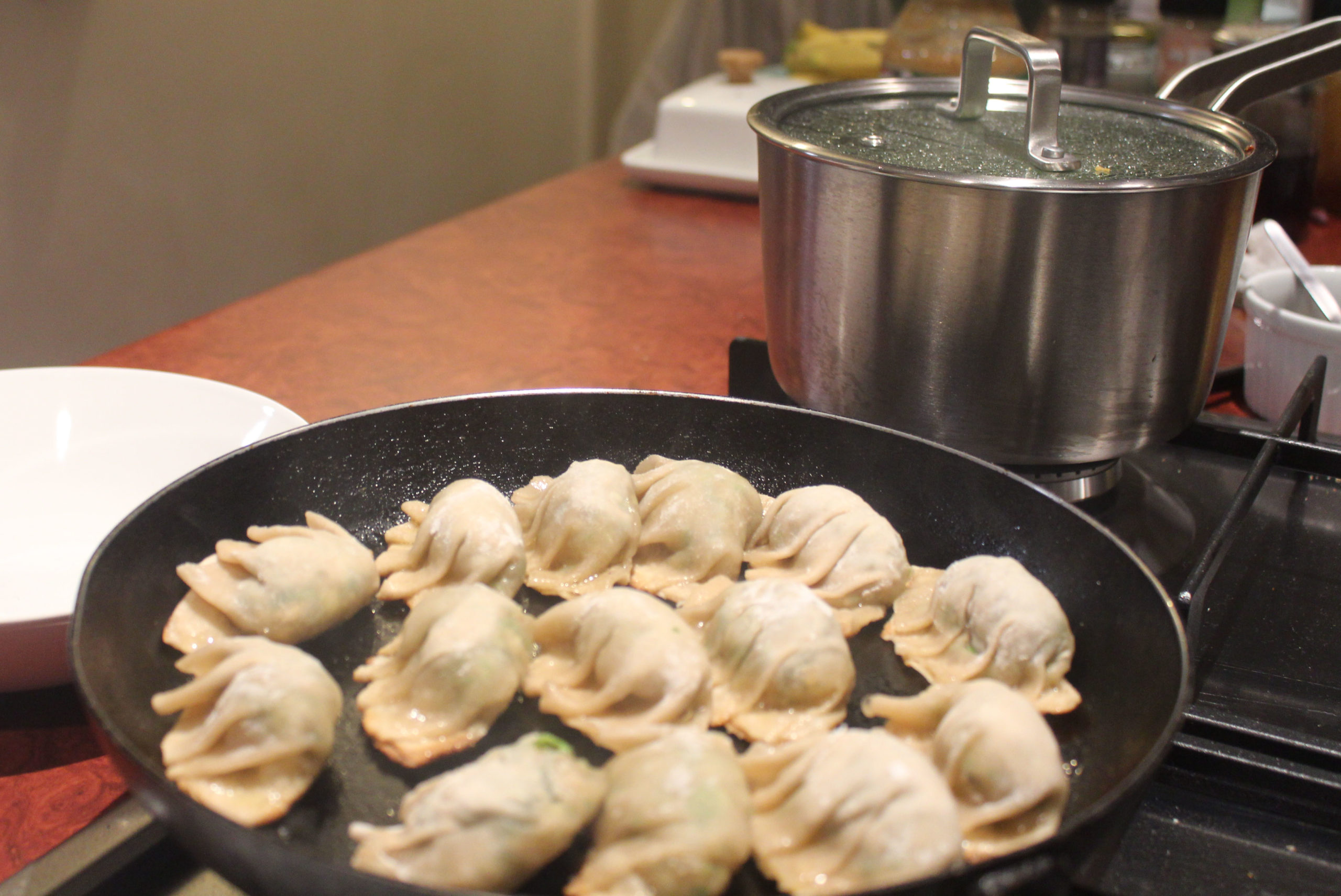FLAVOUR FOLD
Kyoko brings Kyoto to Clovelly

A dumpling dinner can be so much more than the sum of its parts. So what if we all adopted Kyoko Kimura’s attitude of do what you can for others, when you can?
“Our chicken drowned, we’re very sad,” says Kyoko Kimura as she invites me into her thatched house, tumbling down a Clovelly slope. “My husband, Jonathan, wanted us to bury her but I said we should cook her so that’s what we’re doing.”
While I am digesting the demise of the much-loved chicken, Kyoko leads the way to the top of the stairs of her double-volume home where a young woman sits at a table on the landing, making “Mottainai” notebooks. “Zanele Petros is a friend I met through a Buddhist organisation,” explains Kyoko, who set up Origami for Africa, in 2009. “She’s making covers for upcycled notebooks using a traditional Japanese bookbinding method and discarded braille paper and pages from Japanese calendars. In Japan we say ‘Mottainai’, it means ‘Oh no, what a waste’.”
At the big dining table below is Gcobani Kenze, preparing dough for Japanese dumplings or gyozas. Gcobani, who lives in Samora Machel in Philippi, used to work as a cook at the Empire Café in Muizenberg. “I worked there for three years,” he says behind his mask, “but then Dave (David Jones) died – in 2019 – and lockdown.” His voice trails off.
I remember the shock when Empire Café owner Jones (known as the “Mayor of Muizenberg”) died from pneumonia. I remember wondering what would happen to the staff at Empire Café. How did Gcobani, 24, go from working in a Muizenberg café to making dumplings in Kyoko’s house?

Pinch and roll: Gcobani Menze prepares a pile of dumpling wrappers. (Photo: Melanie Farrell)
“My friend Nicole Le Roux used to run a youth mentorship organisation called ‘I Am Somebody’ in Cape Town,” says Kyoko. “She now lives in the US and still keeps in touch with the participants who were part of the organisation a decade ago. She contacted me and asked me if I could help Gcobani, who was unemployed and starving.
“I had met him before and so I asked him to come and see me and taught him how to make gyozas so that he makes some money once a week.”
Kyoko takes a (limited) number of orders for gyozas from Clovelly neighbours and it’s a case of who replies fastest to the weekly WhatsApp because within minutes of announcing the gyoza flavour of the week, another WhatsApp comes in telling us they’re sold out.
Kyoko learnt to make dumplings from her mother while growing up in Japan.
“My parents were struggling financially when they were raising us four children. My mother was not a very typical Japanese housewife who enjoys cooking.
“She was passionate about improving our society through community works but she tried to make homemade food and sweets as well as she could. Filling the gyoza dumplings was often done by us children.”
Gcobani pinches off a small blob of dough and rolls it between his hands, making it into a ball. Then he flattens the ball into a thin disc with a wooden rolling pin, placing it onto a growing pile of dumpling cases.
“Come with me. I’ll show you the chicken,” says Kyoko, leading the way up a steep path outside the back door to an open fire where a large black pot sits, the drowned chicken simmering inside.
“Can you see those yellow blobs?” says Kyoko, pointing. “Those are the chicken’s eggs. Chickens are like humans in that way: they are born with a finite number of eggs.” The yellow blobs are all different sizes, some tiny, some like big marbles.

‘Do you eat egg?’ says Kyoko Kimura, spearing something in a big pot with a long skewer. (Photo: Melanie Farrell)
Back in the kitchen Kyoko asks me if I eat egg and when I say yes she fishes around in a pot on the stove and skewers something that she places on a plate, and drizzles some soy sauce over.
“That’s for you, it’s one of the eggs from inside the chicken,” says Kyoko.
It doesn’t look very appetising, I can see spidery veins on the surface of the yolk, but I pick up the skewer and take a bite. It’s firm but soft and the stock has given the yolk a delicate flavour. The soy adds saltiness, necessary with egg.
Kyoko reaches into the pot with a slotted spoon and removes another egg that’s had a bit longer to cook because it has a soft shell. It looks like a regular egg but because it was harvested before being laid the shell is supposed to be edible. Kyoko arranges the egg on a plate with some turnip and calls Jonathan, her husband and also keeper of the flock of chickens. Formerly 10, now nine layers.
Jonathan disappears with his soft-shelled egg, reappears 10 minutes later. “What did you think,” asks Kyoko. “Egg was good but I couldn’t eat the shell,” says Jonathan.
I’m offered some cooked turnip cubes. It’s delicious, like no other turnip I’ve ever tasted. I was raised on my mother’s homemade Cornish pasties so I know my turnips.
Gcobani is in the kitchen, chopping vegetables for the gyoza filling. “I buy the veggies from Neighbourhood Farm in Fish Hoek and we also use herbs and greens from our veggie garden,” says Kyoko. “It’s a fine mixture of organic garden greens, tofu, ginger, hemp seeds, spring onions, herbs, pecan nuts, garlic, mushroom and seaweed. And it is made with my homemade miso with non-GM soya beans.”
Filling and folding the gyozas requires a calm hand and deft fingers. Once Gcobani has prepped the wrappers and filling Kyoko starts assembling the delicate dumplings.
She cradles a disc in her hand, spoons some filling into it, folds over and pleats, first in one direction, then in the other. (Watch this video Secrets to Juicy Dumplings for tips about how to make, cook and serve gyoza.)

Was I nervous the first time I cooked gyoza home alone? Yes I was. (Photo: Melanie Farrell)
The first time I cook Kyoko’s delicate dumplings at home I’m nervous. What if I mess up? I’ve never cooked dumplings. Kyoko’s Whatsapp instructions are simple: “Fry them until golden on the bottom, add 80ml of water and cover with a lid. When water is boiled away they will be done.”
I understand the bit about frying the bottom till golden but I hesitate when it comes to adding water to the pan. What if it goes all soggy on the bottom? Pour. The water hits the hot pan with cauldron-like sounds and steam billows out. Lid goes on. There’s a lot of noise – crackles and pops as the water evaporates.
I force myself to wait until all the water is gone.
Lift the lid to perfectly steamed dumplings, all billowy and plump.
I quickly make some “gyoza sauce”, another WhatsApp Kyoko sends out.
How to make gyoza sauce at home
4 tsp shoyu (soy sauce)
Vinegar (rice vinegar in Japan, can be apple cider or any vinegar, in case of apple cider vinegar I would start with less)
Bit of honey or sugar or mirin
Sesame oil or chilli oil
Mix.
The bases are still crunchy and golden while the top is soft and the fresh flavour of the filling combines with the dipping sauce in a rich, comforting mouthful.
“I have a Japanese friend called Mineko Yoshimura in Durban who runs a Japanese lunchbox (O-Bento) catering business,” says Kyoko. “She mentioned to me that she feels the best way for us immigrants to repay our debt of gratitude in staying in SA is to create jobs.
“During the lockdown, her words kept coming back to me because we all should be doing something to change this grave situation in South Africa.
“I have some skills that could be useless (as almost everyone can do better than me) in Japan but can be useful in South Africa. I have education and networks. If I could give some income to a few unemployed people, those around them could benefit.
“Focusing on creating jobs for others encouraged me to start something new, got me out of my comfort zones, and it has given me a chance to show my own kids that even a bad housewife can help change the world in a small way, like my parents did,” says Kyoko.
Apart from her own projects with origami, bookbinding and Japanese dumplings, Kyoko is active in the local Clovelly CAN (part of the broader Cape Town Together movement) which has partnered with 10 soup kitchens in Wesbank on the West Coast. “We also organised workshops with permaculture expert Imraan Samuels from NPO Guerilla House for a veggie garden group consisting of volunteers keen to start growing their own vegetables,” says Kyoko.
When I get home Kyoko sends me a photo of her extended “family” (Jonathan, son Taiji, “Mottainai” bookmaker Zanele Petros and chef Gcobani) enjoying the chicken feast in the garden. Kyoko’s caption reads: “Gcobani cooked for us and we ate everything, even the intestines of the chicken. Nothing was wasted. I think this doesn’t really happen in an urban area anymore. This kind of meal gets five stars from me.”
Kyoko hopes that she will be able to help Gcobani to find more work, making dumplings for more people.
When Kyoko’s “Kyoko to Kyoto” WhatsApp message pops up on a Tuesday, I immediately reply: “Yes please, Kyoko!” DM/TGIFood
Until Gcobani Menze is keen to set up his own small business, Kyoko Kimura is happy to be his contact: [email protected]
SUBSCRIBE: There’s much more from Tony Jackman and his food writing colleagues in his weekly TGIFood newsletter, delivered to your inbox every Friday. Subscribe here. Also visit the TGIFood platform, a repository of all of 0ur food writing.
The writer supports Clovelly CAN which helps the communities of Wesbank and Ocean View with fundraising and soup kitchens. See Clovelly CAN on Facebook.



 Become an Insider
Become an Insider
Love a dumpling.